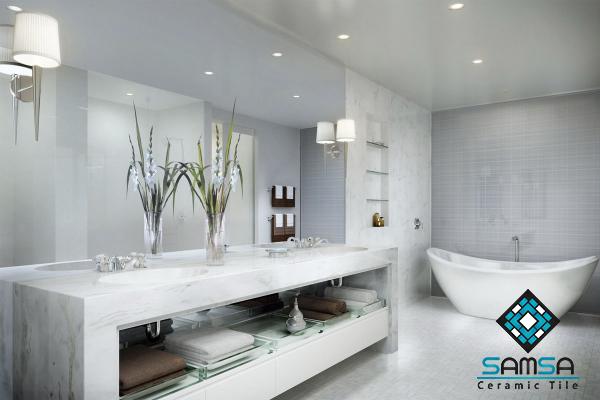Tiles play a crucial role in enhancing the overall aesthetics and functionality of our living spaces. When it comes to choosing between floor tiles and wall tiles, there are several factors to consider. This article aims to provide a comparative analysis of floor tiles and wall tiles, shedding light on their various features, applications, and considerations for homeowners and businesses alike. 1. Material Composition: Floor tiles and wall tiles differ in their material composition, which impacts their durability and suitability for specific areas. – Floor tiles: Typically, floor tiles are made from materials such as ceramic, porcelain, natural stone, or vinyl. These materials are chosen for their durability and ability to withstand foot traffic and heavy loads. – Wall tiles: Wall tiles can also be made from similar materials, but they are often thinner and less dense.

.
 They are designed to be lightweight and easier to install on vertical surfaces. 2. Design and Aesthetics: Both floor tiles and wall tiles come in a wide range of designs, patterns, colors, and finishes. – Floor tiles: Due to their need for durability, floor tiles often feature stronger and harder finishes. They come in various textures, including matte, glossy, or textured surfaces, catering to different aesthetic preferences. – Wall tiles: Wall tiles provide more design freedom, as they are primarily chosen for their appearance. They offer a plethora of options, including decorative tiles, mosaics, and three-dimensional designs that allow for creative expression.
They are designed to be lightweight and easier to install on vertical surfaces. 2. Design and Aesthetics: Both floor tiles and wall tiles come in a wide range of designs, patterns, colors, and finishes. – Floor tiles: Due to their need for durability, floor tiles often feature stronger and harder finishes. They come in various textures, including matte, glossy, or textured surfaces, catering to different aesthetic preferences. – Wall tiles: Wall tiles provide more design freedom, as they are primarily chosen for their appearance. They offer a plethora of options, including decorative tiles, mosaics, and three-dimensional designs that allow for creative expression.
..
 3. Application: Another key factor in deciding between floor tiles and wall tiles is their specific application. – Floor tiles: These tiles are designed for high traffic areas such as kitchens, bathrooms, and living areas. They are engineered to withstand heavy foot traffic, spills, and frequent cleaning. – Wall tiles: These tiles are primarily used in areas with lower foot traffic, such as bathrooms, kitchens, and decorative features in living spaces. They are not subjected to the same level of wear and tear as floor tiles. 4. Maintenance and Durability: The maintenance requirements and durability of floor tiles and wall tiles differ due to their varied applications.
3. Application: Another key factor in deciding between floor tiles and wall tiles is their specific application. – Floor tiles: These tiles are designed for high traffic areas such as kitchens, bathrooms, and living areas. They are engineered to withstand heavy foot traffic, spills, and frequent cleaning. – Wall tiles: These tiles are primarily used in areas with lower foot traffic, such as bathrooms, kitchens, and decorative features in living spaces. They are not subjected to the same level of wear and tear as floor tiles. 4. Maintenance and Durability: The maintenance requirements and durability of floor tiles and wall tiles differ due to their varied applications.
…
 – Floor tiles: Due to their heavy-duty nature, floor tiles are generally more resistant to scratches, stains, and impact. They are easier to clean and require less maintenance compared to wall tiles. – Wall tiles: Wall tiles are less exposed to wear and tear, but they may be more susceptible to stains and scratches. These tiles often require proper sealing, especially in areas prone to moisture and humidity, like bathrooms. Conclusion: Choosing between floor tiles and wall tiles requires careful consideration of various factors, including material composition, design, application, maintenance, and durability requirements. While floor tiles are designed to withstand heavy traffic and provide long-lasting durability, wall tiles offer greater design flexibility and aesthetic appeal. Ultimately, the choice between floor tiles and wall tiles depends on the specific requirements and preferences of the space they are intended for.
– Floor tiles: Due to their heavy-duty nature, floor tiles are generally more resistant to scratches, stains, and impact. They are easier to clean and require less maintenance compared to wall tiles. – Wall tiles: Wall tiles are less exposed to wear and tear, but they may be more susceptible to stains and scratches. These tiles often require proper sealing, especially in areas prone to moisture and humidity, like bathrooms. Conclusion: Choosing between floor tiles and wall tiles requires careful consideration of various factors, including material composition, design, application, maintenance, and durability requirements. While floor tiles are designed to withstand heavy traffic and provide long-lasting durability, wall tiles offer greater design flexibility and aesthetic appeal. Ultimately, the choice between floor tiles and wall tiles depends on the specific requirements and preferences of the space they are intended for.










Your comment submitted.